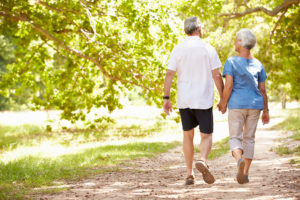Want to hear a scary statistic about aging and your veins? By the time they turn 60, up to 20% of Americans develop
peripheral arterial disease (PAD). This condition affects blood flow to your lower limbs. Want some more age-related statistics? Right when they turn 40, about 20% of American men and 40% of American women have some sort of problem with their leg veins. But why do your veins show more as you age?
The older you get, the more likely you are to develop some type of vein or arterial disease. Which means you really need to understand the variety of conditions that can affect your vein, and start exploring your treatment options—before problems start developing!
But it doesn't mean you're safe from complications if you're younger. Because, as we'll see in this post, trouble can strike at any age. Let's take a closer look.
Varicose Vein Risk by Age
Most people develop
varicose veins later in life. But the underlying conditions that cause these veins to develop? They can start developing much earlier. So if you intervene in time, you may prevent those bulging, twisted veins from ever becoming visible.
Here's the story. When working properly, your veins' one-way valves help blood fight gravity to return to your heart. But if they malfunction, pressure increases in your veins, and you may develop varicose veins, along with other symptoms. Now, these changes take time to develop, which is why many people don't notice varicose veins in their 20s or 30s.
But life changes such as
pregnancy, or even staying home too much and
gaining weight during the pandemic, could speed up the process of damage and malfunction. So people may start noticing these bulging veins at younger ages. Still, other, more serious forms of vascular disease are mostly tied to aging and your veins.
What causes PAD and vein disease? 
PAD is most often a result of atherosclerosis, a slow process during which a fatty material (plaque) builds up in your arteries, reducing blood flow. Smoking, diabetes, high blood pressure and high cholesterol all increase your PAD risk.
Recently, we learned that your height is also a risk factor. In fact, a study from the University of Exeter, shows that people who are tall have a higher risk for varicose veins. (For the purposes of the study, 'tall' meant measuring above 5"9. And if that sounds awful, take heart. Researchers learned that being this tall does lower your risk for heart disease, high
cholesterol and
high blood pressure.)
But regardless of height, your age affects your risk for vein health concerns. In fact, passing the 50 year mark, and having a family history of PAD, heart disease or stroke, are two key risk factors for this dangerous condition.
Aging and Your Veins: PAD Symptoms
PAD progresses slowly for some people. And this condition also shares similar symptoms with many other conditions, making it harder to diagnose. Still, there are classic PAD symptoms. These include:
Muscle pain, leg cramps, or heaviness when walking (this typically resolves after a few minutes of rest.)
· Calf pain
· Numbness or weakness
· Pain in your buttocks
· Cold legs and feet
· Leg and/or foot ulcers
· Hair loss or slower hair growth
What is CVI and What are its Symptoms?
Now, let’s take a look at
chronic venous insufficiency (CVI). This condition occurs when the valves of your leg veins stop working well, making it harder for blood to flow up to your heart. Instead, that blood can pool up in your legs, leaving you with symptoms like bulging, noticeable
varicose veins.
Other symptoms include:
· Sore, tired, restless and/or heavy legs
· Pain or fatigue
· Blood clots, especially
Deep Vein Thrombosis (DVT)
· Leg, foot or ankle swelling (edema)
· Hard, thickened skin
· Changes in skin color
While PAD and CVI can strike anyone, at any time, the older you are, the higher your risk of developing either condition. So, if you’ve noticed a change in the way your legs feel, and your 40th birthday has passed, it’s a good idea to schedule a diagnostic ultrasound to rule out or diagnose a developing vein or arterial condition.
Source Page: https://texaseva.com/sources/

